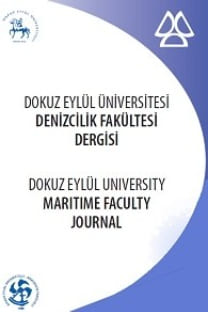ULUSLARARASI TİCARETİN GELECEĞİ İNSANSIZ GEMİLER: GZFT ANALİZİ VE HUKUKİ BOYUTLARI
İnsansız gemiler, denizcilik sözleşmeleri, insansız gemilerin yasal boyutları, deniz taşımacılığı, deniz ticareti
UNMANNED SHIPS WHICH ARE THE FUTURE OF INTERNATIONAL TRADE: SWOT ANALYSIS AND LEGAL ASPECTS
Unmanned vessels, shipping conventions, legal aspects of unmanned vessels, marine transportation, marine trade,
___
- Algantürk Light, D. (2007). Deniz İş Sözleşmesi 2006 Hakkında İnceleme ve Değerlendirme. Erzurum Üniversitesi Hukuk Fakültesi Dergisi (EÜHFD), XI (1–2), 274. Deketelaere, P. (2017). The legal challenges of unmanned vessels, Master of Science in Maritime Science Master Dissertation, Universiteit Gent, Belgium. Kender, R., Çetingil, E. ve Yazıcıoğlu E. (2016). Deniz Ticaret Hukuku Temel Bilgiler. Cilt-1, İstanbul: On İki Levha Yayıncılık A.Ş.
- Köksal, T., Ece, N.J. ve Özkara, B.Y. (2012). Deniz, Lojistik ve Taşımacılık Hukuku. Ankara: Adalet Yayınevi.
- Man, Y., Lundh and M., Porathe, T. ve Kinnon, S., M. (2015). From Desk to Field - Human Factor Issues in Remote Monitoring and Controlling of Autonomous Unmanned Vessels. Procedia Manufacturing, 3, 2680.
- Pence, C. (2018) . Deniz kazalarında insan faktörü ve bir çözüm olarak e-seyir. Akıllı Ulaşım Sistemleri ve Uygulamaları Dergisi, 1(2), 72-86.
- Şamlı, K.Y. (2013). Lahey-Lahey/Visby, Hamburg ve Rotterdam Kuralları’nda Sefere Elverişlilik. İstanbul Üniversitesi Hukuk Fakültesi Mecmuası, 71(2), 479-496.
- Wrobel, K. ve Krata, P. (2016). Towards the Development of a Risk Model for Unmanned Vessels Design and Operations. TransNav, 10(2), 270-273.
- Wrobel, K., Montewka, J. ve Kujala, P. (2017). Towards the assessment of potential impact of unmanned vessels on maritime transportation safety. Reliability Engineering & System Safety,165, 155-156.
- İnternet Kaynakları:
- Birleşmiş Milletler (BM) Enformasyon Merkezi (2018). Birleşmiş Milletler Deniz Hukuku Sözleşmesi. http://www.unicankara.org.tr/doc_pdf/denizhukuku.pdf, Erişim Tarihi: 04.02.2018.
- Caputo, A. (2018). STCW Electronic Edition. http://www.saturatore.it/Diritto/STCW95.pdf, Erişim Tarihi: 10.01.2018.
- DNV (2012). DNV report shipping 2020. http://www.futurenautics.com/wp-content/uploads/2013/10/DNV_Report .pdf, Erişim Tarihi: 10.01.2018.
- IMEAK, Deniz Ticareti Dergisi (2017).Otonom Gemiler İçin Rolls-Royce - Google Cloud İşbirliği. http://www.denizticaretodasi.org.tr/Shared%20Documents/Deniz%20Ticareti%20Dergisi/kasim_2017.pdf, Erişim Tarihi: 12.02.2018.
- LexMercatoria.org (1997). IMO International Convention On Salvage, 1989, 2-6. https://www.fd.unl.pt/docentes_docs/ma/wks_MA_31688.pdf, Erişim Tarihi: 17.02.2018.
- Lloyd’s Register (2009). Lloyd’s Register Rulefinder 2005 – Version 9.4. COLREGS - International Regulations for Preventing Collisions at Sea.http://www.jag.navy.mil/distrib/instructions/COLREG-1972.pdf, Erişim Tarihi: 17.01.2018.
- Oxford Lib Guides (2018). International trade law: International rules on carriage by sea. Admiralty and Maritime Law Guide (1924). International Convention for the Unification of Certain Rules of Lawrelating to Bills of Lading ("Hague Rules"). http://www.admiraltylawguide.com/conven/haguerules1924.html, Erişim Tarihi: 15.03.2018.
- Rolls-Royce, Ship Intelligance Marine (2016).The Autonomous Ships, Next Step, 2016, 2. http://www.rolls-royce.com/~/media/Files/R/Rolls-Royce/documents/customers/marine/ship-intel/rr-ship-intel-aawa-8pg.pdf, Erişim Tarihi: 12.02.2018
- Sage-Fuller, B. (2015). Legal Framework of UnmannedVessels, MUNIN Final Event. http://www.unmanned-ship.org/munin/wp-content/uploads/2015/06/MUNIN-Final-Event-C-1a-UCC-Legal-framework-for-unmanned-vessels.pdf, Erişim Tarihi: 12.02.2018.
- Tauss Marine (2017). Denizde Can Emniyeti Uluslararası Sözleşmesi (Safety Of Life At Sea – SOLAS. http://www.taussmarine.com/dokumanlar/SOLAS.pdf, Erişim Tarihi: 15.01.2018.
- The United Nations Commission on International Trade Law (UNCITRAL) (1978). United Nations Convention On The Carriage Of Goods By Sea,1978 (The “Hamburg Rules”, 8-12.) http://www.uncitral.org/pdf/english/texts/transport/hamburg/hamburg_rules_e.pdf, Erişim Tarihi: 15.02.2018.
- The Hague-Visby Rules - The Hague Rules as Amended by the Brussels Protocol 1968, http://www.jus.uio.no/lm/sea.carriage.hague.visby.rules.1968/doc.html, Erişim Tarihi: 15.01.2018
- Yücel, A. (2017). Otonom gemiler geliyor.https://www.dunya.com/kose-yazisi/otonom-gemiler-geliyor/374800, Erişim Tarihi: 10.03.2018.
- ISSN: 1309-4246
- Yayın Aralığı: 2
- Başlangıç: 2009
- Yayıncı: Dokuz Eylul Üniversitesi Matbası
ULUSLARARASI TİCARETİN GELECEĞİ İNSANSIZ GEMİLER: GZFT ANALİZİ VE HUKUKİ BOYUTLARI
SALIM TİCARETİ SİSTEMİNİN TÜRK DENİZ TAŞIMACILIĞI VE FİNANSAL RAPORLAMA AÇISINDAN İNCELENMESİ
Burcu İŞGÜDEN KILIÇ, Levent BİLGİLİ, Alper KILIÇ
BALTIK KURU YÜK ENDEKSİ’NİN ÖNCÜ GÖSTERGELER İLE TAHMİNİ
Duygu ŞAHAN, Reha MEMİŞOĞLU, Sadık Özlen BAŞER
SALIM TİCARETİ SİSTEMİNİN TÜRK DENİZ TAŞIMACILIĞI VE FİNANSAL RAPORLAMA AÇISIN-DAN İNCELENMESİ
Burcu İŞGÜDEN KILIÇ, Alper KILIÇ, Levent BİLGİLİ
DENİZ TURİZMİNİN GELİŞİMİ İÇİN YÖNETİŞİM İHTİYACI: BODRUM BÖLGESİ’NDE NİTEL BİR ARAŞTIRMA
GEMİ VE LİMAN ETKİLEŞİMİ İÇİN ÖNERİLEN ENERJİ YÖNETİM SİSTEMİ MODELİNİN İNCELENMESİ
RESEARCH ON EMISSION TRADING SCHEME IN TERMS OF TURKISH SHIPPING AND FINANCIAL REPORTING STANDARDS
